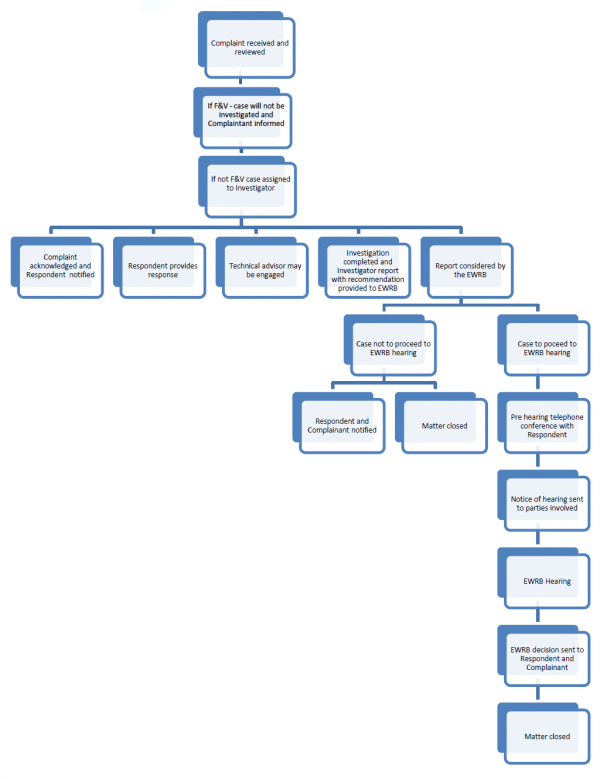Complaints to the Electrical Workers Registration Board - A Quick-Guide
This guide will assist you through the complaint process and help you understand what to expect.
About the Electrical Workers Registration Board
The Electrical Workers Registration Board (the Board) was established under section 148 of the Electricity Act 1992 (the Act).
The Board’s functions include:
- Registration of electrical workers
- Ensuring the competency of electrical workers
- Ensuring the safety of electrical workers and members of the public
The Ministry of Business, Innovation and Employment (MBIE) supports the Board’s functions through administering the Act, however MBIE is independent of the Board.
Complaints About Electrical Work
Like most professional regimes, the Electrical Workers scheme has a disciplinary function to ensure integrity, credibility, and safety.
Complaints can be made about any person and/or company that has carried out prescribed electrical work (PEW) that is believed to be unsatisfactory.
A complaint needs some basis on which it can be investigated within the jurisdiction of the Board. For example, commercial matters cannot be considered by the Board. These matters should be referred to a disputes tribunal.
The two standard complaints processes are:
Complaints against Registered persons are investigated in accordance with Part 11 of the Act – the Disciplinary provisions
Before an investigation commences the Registrar must consider the validity of the complaint;
- If the Registrar determines the complaint is not of a frivolous or vexatious nature an MBIE Investigator will be appointed to investigate the Complaint.
The Investigator will:
- Determine if the complaint falls within the Board’s jurisdiction;
- Determine if the person is registered under the scheme;
- Inform the person complained about (the Respondent) of the nature of the complaint and give the Respondent the opportunity to respond to the allegations;
- Make enquiries and gather information from parties involved.
The Investigator can engage a Technical Advisor to give expertise opinion on compliance and safety matters (section 147 of the Act).
After receiving all relevant information, the Investigator must then provide a report to the Board with their findings and determination of whether the complaint should be heard by the Board.
The Board must accept the Investigator’s recommendation.
- If the Investigator recommends that the complaint should not be considered by the Board, the parties will be notified and sent a copy of the Investigator’s report by the Registrar.
- If the Investigator considers that the complaint should be heard by the Board, the Board must hold a hearing (Section 147G of the Act).
Parties will be advised whether the case is proceeding to a hearing. A teleconference will be held with the Respondent to assess how the matter will proceed.
The options for a hearing are to proceed on the basis of an Agreed Statement of Facts, if the Respondent agrees with the disciplinary offences set out in the Investigator report. If the offences are not agreed a full defended hearing is required.
- In a full hearing the burden is on the Investigator to prove the case to the Board that the offences alleged have been committed.
The Investigator will be represented by an MBIE legal counsel.
In most instances the Board will provide an outcome of proceedings on the day of the hearing and will provide a written decision in the weeks following the hearing.
- The decision can be appealed through the District Court by the Respondent and Investigator only.
- The Board will not enter into correspondence after the decision has been made.
Helpful hints if you have received a complaint against you
- Provide a response to the allegations within the timeframe set by the Investigator.
- Provide a timeline of events and dates that you carried out the work.
- Provide a copy of CoCs that relate to the work.
- Provide names of other electrical workers involved with the work.
- Contact the Investigator to discuss the complaints process and for any updates on the investigation.
Refer to the EWRB website for further information about the complaint process.
Helpful hints for parties making a complaint
- You may be contacted by the Investigator for more information. You can also contact them for updates on the progress of your complaint.
- You may be required to provide additional information to support your complaint.
- Labelled photographs - with a description - should be provided as evidence to support your complaint.
A flow chart to the process is provided below.
View this image full size [PNG, 69 KB]

Flowchart text
Complaint received and reviewed
If F&V* - case will not be investigated and Complaintant informed
If not F&V case assigned to Investigator
- Complaint acknowledged and Respondent notified
- Respondent provides response
- Technical advisor may be engaged
- Investigation completed and Investigator report with recommendation provided to EWRB
- Report considered by the EWRB
- Case not to proceed to EWRB hearing
- Respondent and Complainant notified
- Matter closed
- Case to poceed to EWRB hearing
- Pre hearing telephone conference with Respondent
- Notice of hearing sent to parties involved
- EWRB Hearing
- EWRB decision sent to Respondent and Complainant
- Matter closed
- Case not to proceed to EWRB hearing
* Frivolous or vexatious

